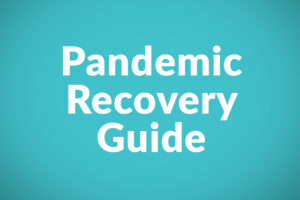Soft Re-Opening of Your Dental Practice
Critical Steps to Success
You made the difficult decision to close your practice in light of COVID-19 concerns to protect your staff, patients, and yourself. Re-opening the practice carries an equal burden as you weigh state mandates, the level of infection in your area, and the health of your dental team and community at large. One overarching issue is determining protocol changes that will nurture and ensure a safety-first culture. Governing agencies will mandate some protocol changes, such as proper PPE, while other changes will hinge on your leadership and guidance. As with all protocol changes, clarity for the entire team brings consistency and compliance.
Refer to the ADA Return to Work Interim Guidance Toolkit as a place to start and OSHA Face Mask Guidance for all Dental Personnel.
Pre-Work
Patient Communication – Assure Your Patients
If you have not been reaching out to patients already, you need to now. Conduct wellness calls and outreach to your patients with your team. Provide some talking points about what to expect. Consider a video you can post on social media to assure patients. Your patients may feel fearful to return to your practice at this time, reassure them of the safety measures you are taking.
“The team wants you to know we’re thinking of you. We want to share some of the things we have been working on here at <Practice Name> and some of the changes you will see. We are installing medical-grade air purifiers to help keep you, and our team, safe. We will be limiting the number of people we provide care to at one time to support social distancing. We will be asking patients to wait in their vehicles and we will text you when your room and provider are ready for you. You may also notice different masks and uniforms. We want to assure you we have the best sterilization protocols in place and are closely following the CDC recommendations. Through these challenges, we have gained an even greater appreciation for you, our patients, and we are committed to keeping you safe while you are in our hands. We have also added Teledentistry. If you have any questions or a dental emergency, please call the office and we can set up a teleconference with you. We can do a lot in a teleconference to help you. If you have questions, please call the office. We are here for you. We’ll let you know just as soon as we have an open date.”
For additional recommendations on staying connected with your patients, ask your Account Manager for our resource, “Fostering Personal Patient Connections During Closure”.
Staff Communication – Prepare Your Team
- Conduct a virtual team meeting before re-opening your practice. Let your team know the steps you are taking to keep them safe in this new environment.
- Speak to each staff member individually to ascertain each staff member’s dedication to returning to work and if they are available for additional hours to meet hygiene demand.
- Communicate any changes in hours or workflow in order to follow the ADA recommendations to reduce exposure and maintain social distancing, it may be necessary to divide your team into smaller work groups and extend practice hours. This will create greater convenience for patients that may have had a work interruption and do not want to take time off for dental visits. This also protects staff from the risk of multiple team members needing time off due to an exposure resulting in symptoms.
- Meet with the team at the practice for their N95 fit tests and to accustom themselves to new equipment and PPE (HVE, air purifiers, donning of paper gowns, etc.) More fit testing and PPE information can be found here:
OSHA N95 Fit Test Video
ADA OSHA N95 User Seal Check Video
CDC Strategies to Optimize the Supply of PPE
CDC Donning and Doffing PPE Guide - Conduct an educational “walk through” of all new and prior infection control and workflow protocols along with sterilization assignments.
- Verify each staff member understands their additional duties to follow safety guidelines.
Larger teams may need to participate in this training in smaller groups to maintain social distancing.
Disinfection and Preparation Before Opening
Assign a staff member to the role of “COVID Officer.” It will be their responsibility to keep up with new information released from the ADA and CDC joint task force and implement changes. They will also be responsible for monitoring the implementation and steadfastness of new protocols.
- Disinfect all surfaces within the practice, before opening, with an EPA approved disinfectant. This includes the reception area, treatment rooms, restrooms, front desk area, kid’s area, private offices, and all other spaces inside the practice.
- Remove magazines, toys, hospitality items, and pamphlets from the reception area.
- Clear ALL counter spaces in treatment rooms and reception areas. Remove non-essential items such as tissue boxes, displays, magazines, and photo books.
- Clean the sterilizing units and complete a spore test.
- Clean and disinfect water bottles, reservoirs, water lines, amalgam traps, and handpieces according to manufacturer directions.
- Stock Ops with appropriate PPE.
- Contact your Burkhart Service Coordinator for equipment specific protocols and resources. (We’ve expanded our service hours to be available when you need us and are applying technician safety measures.)
- Follow all guidelines created by the ADA and OSHA for disinfection.
Environmental Protection/PPE Updates – Teach Your Team
Prepare the practice with proper safety measures, including the correct PPE for staff as recommended by the ADA, CDC, and your state governing agencies. See: Interim Mask and Face Shield Guidelines and ADA Return to Work Interim Guidance Toolkit.
Meet with your team again remotely to review protocols and safety measures; this allows the team an opportunity to feel safe and better explain safety measures to patients. This may include the following:
- N-95, or level 3 surgical masks, in addition to face shields for high aerosol producing procedures.
- Front desk team members may need to wear masks if they are within six feet of aerosol producing treatment. This includes N95 or level 3 masks as determined by the ADA and CDC. Level 1 masks are sufficient as a precaution when outside of the six-foot radius.
- High vacuum use for high aerosol producing procedures, including ultrasonic instrumentation by hygienists. Dental assistants should support hygienists with the HVE during ultrasonic scaling procedures.
- Incorporate rubber dams whenever possible
- Pre-procedural rinses
- Air purifying systems
- Extraoral HVE options
- Temperature checks on all staff members and patients on arrival
- Disposable gowns
- Antibody testing
- Shoe coverings
* Monitor the ADA website for the latest recommendations regarding PPE and sterilization protocols.
Clinic Scheduling
- Stagger Ops, when possible, using every other Op rather than side-by-side Ops, to reduce the aerosol impact. This is particularly important with open-bay treatment areas. This may require moving pre-scheduled patient appointments to meet this requirement.
- Stagger patient appointments to avoid a line forming at the front desk/checkout area or the potential for a group of people forming in the reception area.
- Add time to appointments to allow for heightened sterilization protocols (additional 10-20 minutes, depending on changes).
- Prioritize scheduling patients based on the following criteria:
- Those who were re-scheduled more than once
- Those overdue for SRP and periodontal maintenance procedures (especially those with underlying conditions)
- Those with treatment in process (temporaries, etc.)
- Patients reporting discomfort
- Higher fee services to infuse cash flow back into the practice quickly
Opening
Patient Announcement
- Update your website and social media channels with your anticipated opening date and offer words of reassurance regarding added sanitation and infection control protocols incorporated for their safety. Let them know what to expect upon their arrival.
- Reach out to your Burkhart Account Manager for sample scripting.
- Send an email to the patient base to let them know you have re-opened, the steps you are taking to protect them, added hours to serve them if applicable, and encourage scheduling.
- Reach out to your Burkhart Account Manager for an example email.
Patient Confirmation Changes
- Incorporate screening questions to assess health. Include health screening questions as recommended by the CDC and ADA:
- “Please understand we are pre-screening all patients out of care for everyone’s safety…”
- Explain new arrival protocol – call or text on arrival, wait in vehicle, no visitors in the clinic.
- “To ensure your, and our other patient’s, safety through social distancing, please call or text us from your vehicle when you arrive for your appointment. We will respond, letting you know the next steps. Please be aware no visitors are allowed in the clinic at this time, only the patient being treated.”
- Ask patients to update their health history online. When not possible, they should update in a private area that is sterilized immediately afterward – including pens and electronic devices. When using pens, consider letting the patient keep the pen after use.
Patient Arrival – New Protocols
- Modify the check in process
- The patient should call or text on arrival and wait in their vehicle until the Op is available.
- If the patient is unable to wait in their vehicle, care should be taken to make sure there is a six-foot distance between patients in the reception area. This may require the removal of extra chairs positioned closely together.
- When possible, add signs in front of parking stalls with instructions.
- Customize our Practice Entrance Sign for the front door indicating the reception area is closed as an added health protection measure.
- Restrict entry into the clinic for patients only, asking visitors and family members to wait in their vehicles. This reduces encroachment of the 6 foot recommended distancing for other patients and staff members.
- Provide a barrier or instruct patients to maintain a six-foot distance from others.
- Temperature check
- Have a touchless, laser thermometer available to screen patients (and staff) for temperatures. Refer patients with temperatures above 100.4ºF to their medical provider and reschedule when symptoms are no longer present.
Additional guidance: CDC Guide on Temperature Checks
- Hand sanitizing
- Provide touchless hand sanitizing units at the reception area and ask each patient to sanitize their hands on arrival and departure.
Additional guidance: ADA Return to Work Interim Guidance Toolkit
Patient Reassurance Measures Clinicians Need to Take
- Wash hands/use hand sanitizer in front of patient, followed by donning gloves.
- Leave bag of sterilized instruments on top of tray in view of the patient, let them witness you opening the sterilization pouch and reassure them that this protocol is not new; each patient has a reserved set of sterilized instruments.
- Verbalize safety protocols
- “We’ve worked hard to ensure you and our team are safe. We have equipped the operatories with air purifiers, reduced aerosols through additional suction, and added personal protection to protect you and our staff and doctors from airborne viruses.”
- Ensure countertops are free of all non-essential items such as tissue boxes, models, mirrors, personal items, etc. The countertops should be clear and easy to sterilize. Retrieval of items in drawers can take place as necessary following strict cross-contamination protocols.
- Sanitize bathrooms, consult room, reception area, and door handles after each use or every two hours with EPA approved disinfectants. Assign this task to staff members by area.
Post-Treatment Check Out
- To minimize stops at the front desk and maintain social distancing, schedule subsequent appointments in the operatory.
- Consider taking payments at the start of appointments or in the operatory with a portable device. Offer remote payment options such as pay-by-text or through your practice management software. Limit the number of times a patient must stop at the front desk.
- Complete financial arrangements in the operatory or in the consult room followed by thorough sterilization of the room.
- Email treatment plans to patients, offer to review details, and schedule via phone, email, or text.
End of Day
Continue to follow all ADA and CDC guidelines concerning changing uniforms, hand washing, care and laundering of scrubs/lab coats, etc.
Additional Considerations
Team Meeting Changes
- Morning Huddles need to support a 6-foot distance. Smaller team huddles may need to take place or can be conducted through a platform such as the Zoom app on phones to maintain a safe distance.
- Provide an alternative to eating in the lunchroom to maintain a 6-foot distance. Allow staff an opportunity to prepare and store food in the lunchroom and direct them to alternative places to eat such as outside or in their vehicles.
- Reduce staff-to-staff and staff-to-patient contact as much as possible; locate or remove chairs in such a way to support a 6-foot distance. This includes chairs in a checkout area, reception area, and lunchroom.
Deliveries
- Accept and sanitize deliveries outside prior to bringing into the practice.
- Place a sign on the door with delivery instructions: sample sign
- Use gloves to sign electronically for packages.
Added Sanitation Protocols
- Remove all magazines, brochures, toys, books, etc., from the reception area and check-in, checkout areas.
- Enhance job descriptions for all team members to include additional protocols.
- Assign added sterilization protocols to appropriate staff members. These include:
- Wiping down door handles, stair rails, light switches, chair arms, remotes, and countertops outside of clinical Ops.
- Sterilizing Ops includes previous CDC guidelines as well as additional steps to sterilize all countertops, patient chairs, coat hooks, drawer handles, remote controls, etc. Focus on anything a patient may have touched.
- Sterilize all handpiece motors, including slow speeds used for polishing, in-between each patient.
Taking these steps will ensure a successful reopening of your practice focused on your patients’, your team’s, and your continued health.
Your success is our success. Please reach out to us anytime.
Learn more, visit the Practice Support Team page, email us at PracticeSupportTeam@BurkhartDental.com, or call 1.800.665.5323.


